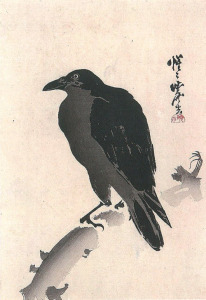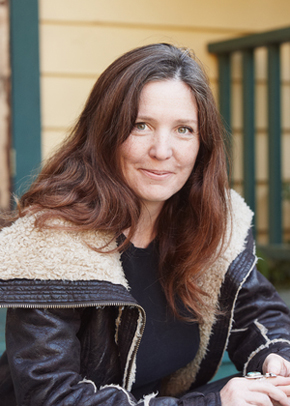Dennison’s dolce vita
by Dennison Smith
“Exceptionally bold, beautiful, original and humane.” Joanna Kavenna
July 9, 2015
“So, where were we?” I say, as she fills her water bottle and I rescue a fragile, yellow spider from the yoghurt container, in which I have packed the blueberries from my bushes. “What were we talking about?”
Ruth Ozeki and I haven’t seen each other in over nine months. Time enough to birth a baby, but not to write a novel. That gestation period trumps an elephant’s. Our scant correspondence over the winter is an expression of our friendship: “Don’t write me; you don’t need to.” We know what time costs each other. Winters are scheduled to busting point. Mine in London, Ruth’s in New York, or almost anywhere in the world where they read her novels. But in the summer, we are surrounded by water, and time, like sound, moves queerly. Our conversation skips between years.
Very little changes on this island. One summer, we celebrate Ruth’s A Tale for the Time Being getting shortlisted for the Booker, another my The Eye of the Day getting picked up by Harper Collins in Canada, and now Periscope in England. But our celebrations are as unmarked as my July and August calendar and could easily be mistaken for summer-business-as-usual: blueberries, a walk and a swim, while talking writing.
Today, we begin with voice.
“I think I’m beginning to find the voice of the new novel,” Ruth says, “I can’t move forward until I’ve found the voice. I don’t mean the style, or the shape of the sentences or the tone. Voice is more far-reaching, more like the attitude of the book towards the world.”
Above us, five enormous ravens talk amongst themselves. Their verbosity is iconic, and their language sounds like Ruth’s jalopy trying to shift gears. Circling on an updraft, a bald eagle gives a soprano squeal – its surprising voice tells a different story than its figure on the dollar bill.
 Crow on a Branch by Kawanabe Kyōsai. Artlino Archive/Wikimedia Commons” width=”206″ height=”300″>“Me, I start from place,” I tell her. “Most of the time, I start from a house and how it sits in the land. Then the house, complicit with the land, conjures its inhabitants.”
Crow on a Branch by Kawanabe Kyōsai. Artlino Archive/Wikimedia Commons” width=”206″ height=”300″>“Me, I start from place,” I tell her. “Most of the time, I start from a house and how it sits in the land. Then the house, complicit with the land, conjures its inhabitants.”
I’m thinking of The Eye of the Day, and Aubrey and Amos, the young scion and disfigured woodsman, whose worlds are irrevocably changed by the violent movements of weather and World War II, and the smaller motions of domestic tragedy. My grandmother’s summer cottage in Vermont gave rise to Aubrey and Amos. Where “the distant mountains purpled in the sunset” and “the sun struck the wings of swallows hunting invisible insects, and the windows of cottages on the eastern shore flashed like signal lamps.” Aubrey’s father says, as mine did every year, “This is what we come a thousand miles to see.”
Now, I travel over seven thousand miles to see yet higher mountains, eagles hunting salmon, and orca off the eastern shore. And islanders know me by another house: the antique yellow jewel on the ‘S-curve’ with the garden rolling down to the lagoon. Visitors imagine it has belonged to me forever, but as of seven years ago, I knew exactly nothing about this island. I came across the house online. I turned to my then-husband and said, “Look, that’s my house. Let’s travel north this weekend to see it.” I had – to the dollar – enough to buy it. And I had no idea that another novelist lived down the trail behind my house, through the old growth woods, past the bluff and sometimes the wolf pack.
“You know what Wallace Stegner wrote?” I ask her. “Tell me where you’re from, I’ll tell you who you are. He’s famous for writing about the American West, but he wrote about Vermont too. He summered up the hill from my home. As a kid I found him kind of scary. But I think his presence up there had more effect on me than I knew.”
We stop talking shop long enough to lament the hundreds of blueberries I lost to a gang of robins. I tell Ruth how I’ve sited my writing chair by the bushes, and how I throw down my laptop to chase the thieving birds. It’s my version of stretching my legs. She tells me about the fat-cat racoon window-shopping for the new season on the limbs of her unripe fig tree and suggests I get myself a slingshot.
But summer plunder is typical. The jays will get my hazelnuts; the racoons will get my grapes. (Can I really call them mine?) There’s a migrant grizzly on a nearby island. He’ll probably take some of the hives. And my neighbour lived for weeks with a cougar in her backyard, as she and he both patiently awaited the rotting of his kill. (Cougars like their deer meat ripe.) I appreciate how the foragers and predators put me in my place: secondary in this teeming ecosystem. And that I still find the robins jolly, even as they eat my berries, reminds me that my survival does not depend on my harvest, yet.
That may change. This summer, a perfect cherry crop rotted out from the inside due to the latest pest brought to the island by climate change. And the starfish, who died en masse last year, have not resurrected. And everywhere the shallow wells were August-dry in June. Time slows on the island, but I can’t claim nothing changes.
In The Eye of the Day, it seems to Aubrey and Amos that “Vermont didn’t change except in storms, when the mountains disappeared” and “when the weather passed, it changed right back again.” And yet their entire world is on the cusp of the unrecognizable.
The changes on this island are the deepest changes, the kind you can’t crawl back from, like growing suddenly older. As I write this, forest fires blaze across the strait to the west and over the eastern mountains. Tomorrow will be thick with wood smoke. We’re warned hourly by the radio to watch where we throw our butts.
 Change happens in an instant; then it sticks around for years. This is the same island that Ruth’s narrator ‘Ruth’ inhabits in A Tale for the Time Being, and onto whose shores floated the flotsam of the Fukushima earthquake. Today, Pacific Coast fishermen continue to haul in radioactive fish.
Change happens in an instant; then it sticks around for years. This is the same island that Ruth’s narrator ‘Ruth’ inhabits in A Tale for the Time Being, and onto whose shores floated the flotsam of the Fukushima earthquake. Today, Pacific Coast fishermen continue to haul in radioactive fish.
Our conversation turns to the tension between autobiography and fiction, something which, after A Tale, Ruth knows a lot about.
“I thought about writing myself into A Tale years before I did,” she says. “But it seemed too postmodern and metafictional and, you know, too male. And yet I couldn’t get a handle on the narrator. I auditioned various characters for the part. Everyone failed. So I left an abstract place-holder as the narrator. A sort of reader-everyman. Then I waited. Then the terrible, heart-breaking earthquake and tsunami and Fukushima meltdown happened. I have friends and relatives in Japan. I wanted to respond directly to these disasters, and realized I could do so most effectively by stepping into the story myself.”
A Tale depicts time as a feedback loop – circular, volitional, sensitive and serendipitous – in which disparate strands of experience – times, places, characters and philosophies – pull to a single point, then smudge.
To look at me and Ruth, sitting on the rocks, you wouldn’t think our characters were capable of smudging. We couldn’t look more different: she’s Japanese-American and prefers a uniform of grey and black; I’m redheaded and freckled and wear cowboy boots with my frocks. And yet our approach to time in our novels is uncannily similar: non-linear, subjective and mysterious.
‘Writing fiction is one of the most self-revealing things a person can ever do,’ says Ruth. ‘Readers often think that fiction is fiction, and writers pretend it is too.'”
Amos’s time is ancient and circular: “Orion was gone, just as somewhere in the woods of southern Quebec… it had vanished a whole year ago.” And Aubrey’s is disjunctive: “He learned that the eye at war was different than the eye in peacetime. In war, some visions were permanent, like cataracts falling over the eye. Other visions, equally atrocious, were impossible to capture at all – one atrocity being replaced too quickly by another.” And serendipity shapes both of their lives and ultimately draws them together on the Italian front.
My novels are informed by a conception of time inherent to the Native American culture that influenced my youth. Ruth’s dwell in the equally timeless field of quantum theory and Buddha-mind.
“Writing fiction is one of the most self-revealing things a person can ever do,” says Ruth. “Readers often think that fiction is fiction, and writers pretend it is too – to distance ourselves from the vulnerability. But that vulnerability is utterly essential.”
The crew of ravens is at it again. We pause. We both look up.
“We need rain”’ I say, looking for a cloud.
“We won’t get it for at least another two months,” says Ruth, as she snacks on something green and salty growing between the rocks.
These are the azure days of summer. A bay of dolphins; kayaks and cormorants in the lagoon; oysters plucked for dinner off the beach. Soon I’ll give my badminton party, and artists and writers from all over the globe, hidden in this island’s coves and woods, will emerge to sip gin-and-tonics and chase after the birdie. I can plan the event weeks in advance and count on there not being rain.
We enjoy it for the moment. But all over the west, forests are burning. Tomorrow morning, from my cottage window, I won’t see the mountains for the smoke.
I fill my hands with blueberries and say, “I’m thinking of starting a blog and calling it Dennison’s Dolce Vita.”
Ruth slips into the sea.
 Dennison Smith is a novelist, poet and playwright as well as an actor and director. She is the author of two poetry collections and Scavenger, a work of poetic fiction. Originally from Chicago and Vermont, she now splits her time between London and a small island in British Columbia. She holds an MA in Creative Writing from the University of East Anglia, where she is presently teaching and pursuing her PhD in Creative and Critical Writing. The Eye of the Day, her first novel, is published by Periscope. Read more.
Dennison Smith is a novelist, poet and playwright as well as an actor and director. She is the author of two poetry collections and Scavenger, a work of poetic fiction. Originally from Chicago and Vermont, she now splits her time between London and a small island in British Columbia. She holds an MA in Creative Writing from the University of East Anglia, where she is presently teaching and pursuing her PhD in Creative and Critical Writing. The Eye of the Day, her first novel, is published by Periscope. Read more.
dennisonsmith.ca
@dennisonbsmith
Author portrait © David Ellingsen

